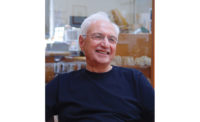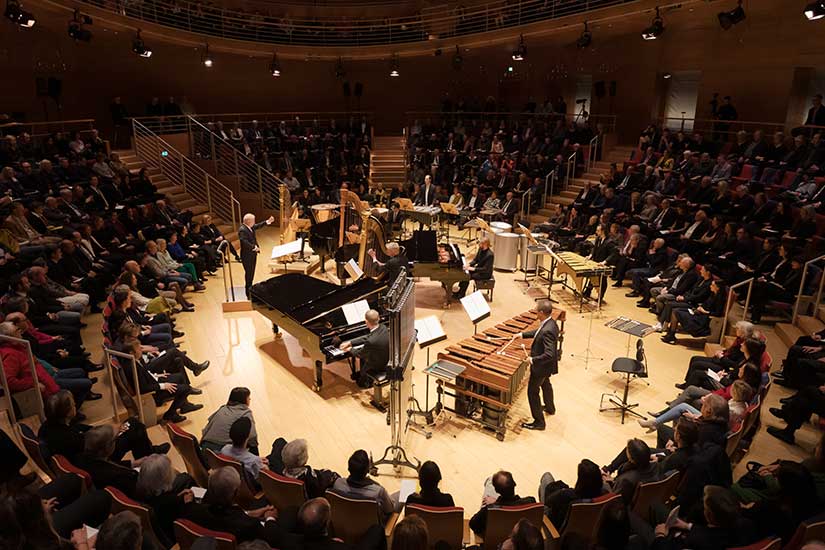Music Melds With Architecture at Frank Gehry’s 90th Birthday Party in Berlin

Frank Gehry celebrated his 90th birthday at the Pierre Boulez Hall, where conductor Daniel Barenboim dedicated a concert to him.
Photo © Peter Adamik

The Canadian American architect was surrounded by loved ones on his milestone birthday.
Photo © Peter Adamik

Gehry designed the 683-seat Pierre Boulez Hall for the Barenboim-Said Academy, which trains young musicians from the Middle East, North Africa, and around the world.
Photo © Peter Adamik



Architects & Firms
Last Thursday, February 28, the Pierre Boulez Hall in Berlin felt, looked, and sounded like a Stradivarius as Daniel Barenboim celebrated Frank Gehry’s 90th birthday in a concert dedicated to the Los Angeles architect. The eminent Berlin-based conductor honored Gehry by playing the wood-paneled hall, finished two years ago, like a resonant instrument, putting it through its paces with music ranging from whispering to explosive. If Le Corbusier (borrowing from Goethe) said that architecture was frozen music, Barenboim defrosted it, inviting Gehry’s warm, environmental cello into vibrant duets with instruments from his chamber orchestra.
By basically performing the hall, Barenboim was giving his friend an unwrapped birthday present, proving through the qualities of the interior why so many people, including a large contingent from Los Angeles, came so far to celebrate the architect. The hall delivered music, most of it passionate, that heightened emotions already brought by his friends. The concert was followed by a champagne reception in the school, where Gehry was surrounded by admirers, and then by a catered dinner that was served on the stage where the musicians had just played.
The circumstances of Pierre Boulez Hall’s existence framed the evening and set the affectionate tone. At Barenboim’s invitation, Gehry designed the interior (pro bono) as a chamber music hall dedicated to their mutual friend, French composer Pierre Boulez, who died in 2016. The 680-seat room is the primary performance space within the Barenboim-Said Academy, an institute formed by Barenboim and the late Columbia scholar Edward Said where young, promising Middle Eastern musicians, especially Palestinians and Israelis, could come together in comity through music. Gehry himself broke concert hall conventions by designing the hall as an oval of seating wrapping a stage at the center, eschewing the usual shoebox with a proscenium stage at the front end. The geometry brings the audience so close to the musicians that the members of the audience can see notes on the page. The unprecedented proximity to the musicians and physical immersion in the sound contributed to the emotional intimacy and intensity of the event.
Barenboim selected three stunning, infrequently heard pieces. Boulez’s devilishly difficult “Anthèmes II” was played on the violin by Michael Barenboim, the conductor’s son, with Paganini-like virtuosity, to electronic accompaniment. The fractal composition synthesized the violin’s normally sonorous sounds, making this analog instrument sound digital. Robert Schumann’s “Andante and Variations in B-flat Major” brought out the honey in the Hall’s acoustics, and it was movingly performed by Daniel Barenboim himself, as pianist, with lifelong friend and colleague Martha Argerich, a pianist from his long-ago beginnings in Buenos Aires, where Barenboim first studied music. With the curves of the pianos arranged in a cupping conjugal relationship, the two pianists accompanied musicians playing cellos and a French horn. The sounds of Schumann’s Andante were as mellow and fluid as Anthèmes’s were jagged and angular.
But the piece de résistance was Pierre Boulez’s “Sur Incises,” a driving, percussive, thrilling piece performed by three pianists, three harpists, and three percussionists. Its insistent rhythms accelerated and climaxed in a thunder-clapping storm. In remarks after the concert, Barenboim said, “What a special day!” declaring that “Sur Incises” announced 21st century music just as “The Rite of Spring” had announced 20th century music. "There is no more suitable piece for the birthday of Frank Gehry because it was no coincidence that Frank built the hall and it was named for Pierre Boulez. They shared so many ideas.”
Indeed, just minutes before his fond remarks, the tempestuous “Sur Incises” had virtually explained the hall. Its driven, asymmetrical rhythms moved in continuously mounting sound masses, just as the compound curves of Gehry’s interior turned continuously into revolving configurations, the changing forms pushing and accelerating space. Boulez had composed his dynamic masterpiece in an empty time structure, the notes beating to their own drummer, just as Gehry had designed the undulating walls and balconies in an empty space structure, outside any discernible columnar or modular measurement: form and space just flowed. Both the musical and architectural compositions were daringly unframed pieces outside any regular beat of time or space. Each was a synesthetic equivalent of the other. The music explained the hall through sound, and the hall visualized the music through the three dimensions, both coinciding in a fourth.
Barenboim closed his affectionate birthday toast expressing his intention to stage another birthday party for Gehry on his 100th.






